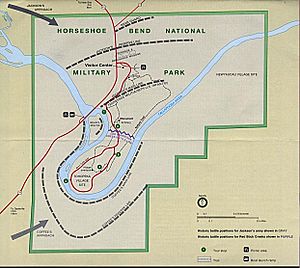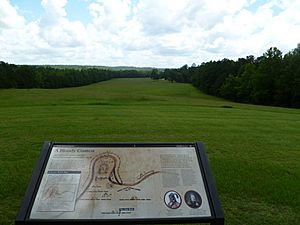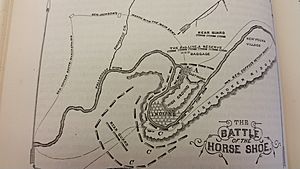Battle of Horseshoe Bend facts for kids
Quick facts for kids Battle of Horseshoe Bend |
|||||||
|---|---|---|---|---|---|---|---|
| Part of Creek War | |||||||
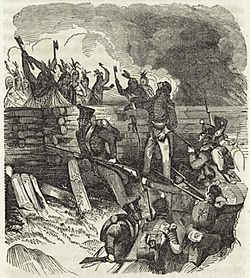 The Battle of Horseshoe Bend |
|||||||
|
|||||||
| Belligerents | |||||||
| Red Stick Creeks | Lower Creek Cherokee Choctaw |
||||||
| Commanders and leaders | |||||||
| Menawa | Andrew Jackson James Neill |
||||||
| Strength | |||||||
| ~1,000 warriors | American: ~2,000 infantry, ~700 cavalry, unknown artillery Native American: ~600 warriors |
||||||
| Casualties and losses | |||||||
| >800 killed 206 wounded |
American: 47 killed 159 wounded Native American: 23 killed 47 wounded |
||||||
The Battle of Horseshoe Bend was a major fight during the War of 1812 in what is now central Alabama. On March 27, 1814, American soldiers and their Native American friends, led by Major General Andrew Jackson, fought against the Red Sticks. The Red Sticks were a group within the Creek tribe who did not want Americans to expand onto their lands. This important battle effectively ended the Creek War.
Contents
Why the Battle Happened: The Background
The Creek Indians lived in Georgia and the eastern part of the Mississippi Territory. They were split into two main groups. The first group was the Upper Creek, also known as the Red Sticks. Most of them did not want Americans to take more land. They sided with the British and Spanish during the War of 1812.
The second group was the Lower Creek. They had closer ties with the Americans. They wanted to stay on good terms with them.
Rising Tensions and Conflict
A Shawnee leader named Tecumseh visited Creek towns in 1811–1812. He wanted to gather warriors to fight against American expansion. The Red Sticks, who were mostly young men, were already forming. They wanted to bring back their old traditions and culture. They started raiding American settlements on the frontier.
The Lower Creek helped American forces capture some of these raiders. Because of this, the Red Sticks then attacked the Lower Creek. In 1813, a group of Red Sticks was returning from getting weapons in Pensacola. Militia troops tried to stop them. The Red Sticks fought back and won at the Battle of Burnt Corn. After this, the Red Sticks continued to raid settlements. In August 1813, they attacked an American outpost at Fort Mims.
America Joins the Fight
After the attack on Fort Mims, settlers asked the government for help. The main U.S. army was busy fighting the War of 1812 against Great Britain. So, the states of Tennessee, Georgia, and the Mississippi Territory formed their own militia groups. These militias, along with their Lower Creek and Cherokee allies, went to fight the Red Sticks.
General Andrew Jackson led his army from Fort Williams in the spring of 1814. They marched through the forest towards the Red Sticks' camp. This camp, called Tehopeka, was near a bend in the Tallapoosa River. This area is now in central Alabama. Jackson sent General John Coffee with some soldiers and Native American allies. They went south across the river to surround the Red Sticks' camp. Jackson stayed with the rest of his soldiers north of the camp. His forces included the 39th United States Infantry. They also had about 600 Cherokee, Choctaw, and Lower Creek warriors.
American Forces at Horseshoe Bend
| Brigade | Regiments and Other |
|---|---|
| Headquarters
|
|
| Doherty's Brigade
Brigadier General George Doherty |
|
| Johnson's Brigade
Brigadier General Thomas Johnson |
|
| Coffee's Brigade
Brigadier General John Coffee |
|
The Battle: March 27, 1814
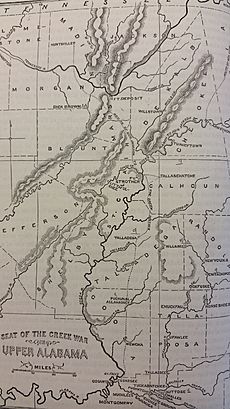
On March 27, 1814, General Andrew Jackson led his troops up a steep hill near Tehopeka. His army had 2,600 American soldiers, 500 Cherokee, and 100 Lower Creek allies. From this high spot, Jackson planned his attack on the Red Stick fort. At 6:30 am, he divided his troops. About 1,300 men crossed the Tallapoosa River to surround the Creek village.
Then, at 10:30 am, Jackson's remaining troops began firing their cannons. They shot for about two hours. But the Red Sticks had built strong defenses. Their log-and-dirt walls were 400 yards long. The cannons did little damage to them. Jackson was very impressed by how well the Red Sticks had protected their position. He later wrote that their defenses were "really astonishing."
Hand-to-Hand Combat
Soon, Jackson ordered a bayonet charge. The 39th U.S. Infantry, led by Colonel John Williams, charged the walls. They fought the Red Sticks in hand-to-hand combat. Sam Houston, who later became a famous leader in Texas, was a young officer in Jackson's army. He was one of the first to get over the log barrier. He was wounded by a Creek arrow, which bothered him for the rest of his life.
Meanwhile, General John Coffee's troops had successfully crossed the river. They surrounded the camp and joined the fight. This gave Jackson a big advantage. The Creek warriors refused to give up. The battle lasted for more than five hours. In the end, about 800 of the 1,000 Red Stick warriors were killed. Jackson's army lost fewer than 50 men and had 154 wounded. Chief Menawa was badly hurt but survived. He led about 200 warriors across the river to safety. They joined the Seminole tribe in Spanish Florida.
What Happened Next: The Results
On August 9, 1814, Andrew Jackson made the Creek sign the Treaty of Fort Jackson. The Creek Nation was forced to give up 23 million acres of land. This was half of central Alabama and part of southern Georgia. This land included territory that belonged to the Lower Creek, who had been allies of the United States. Jackson decided which areas to take based on what he thought the U.S. needed for security. About 1.9 million acres of the land taken was also claimed by the Cherokee Nation, who had also helped the U.S.
Jackson's Rise to Fame
After this victory, Jackson sent his scout, John Gordon, to Pensacola. Gordon found out that the British were using the Spanish fort there to arm the Red Sticks. With this information, Jackson took Pensacola. This led to another battle against the British in New Orleans.
The victory at Horseshoe Bend, along with the Battle of New Orleans, made Jackson very famous. His popularity grew, and he was well-known when he successfully ran for President in 1828.
Legacy of the Battle
The battlefield is now a protected area called the Horseshoe Bend National Military Park. It helps people remember this important event. Two active battalions of the U.S. Army, the 2nd and 3rd Battalions of the 7th Infantry Regiment, carry on the history of the old 39th Infantry Regiment. This regiment fought bravely at the Battle of Horseshoe Bend.
In Books
The Battle of Horseshoe Bend has appeared in books. Eric Flint wrote a series of alternate history novels called Trail of Glory, which start with this battle. In his story, Sam Houston is only slightly wounded. This allows him to have a different career path. Also, the main character in Paulette Jiles' novel News of the World, Captain Jefferson Kyle Kidd, fought in this battle as a 16-year-old under Jackson.


